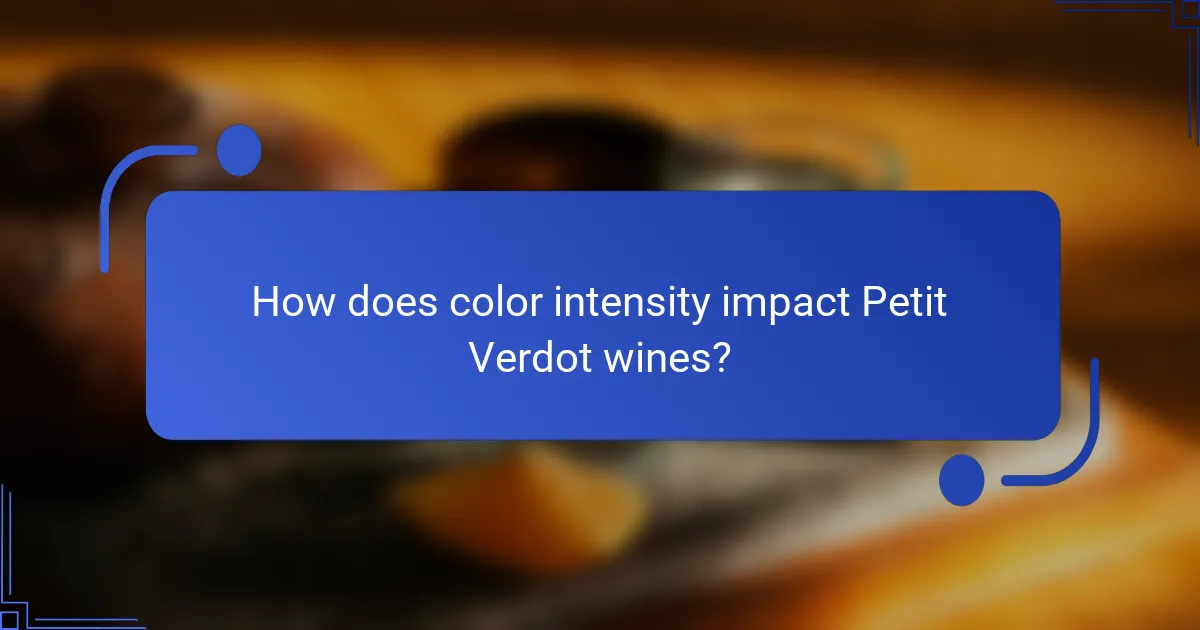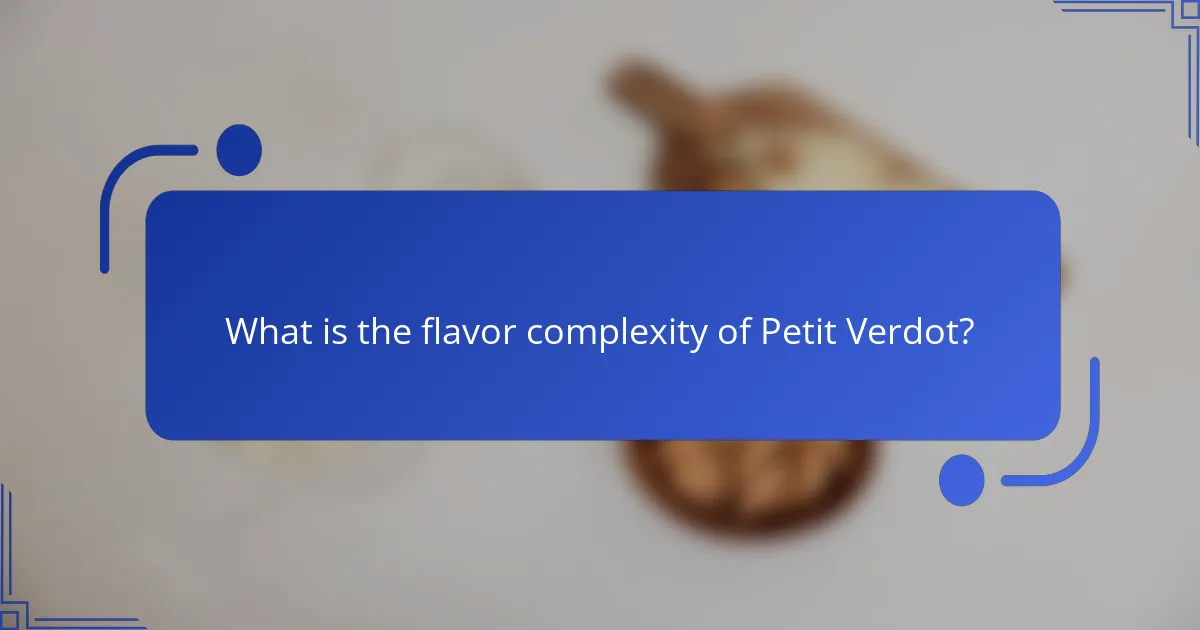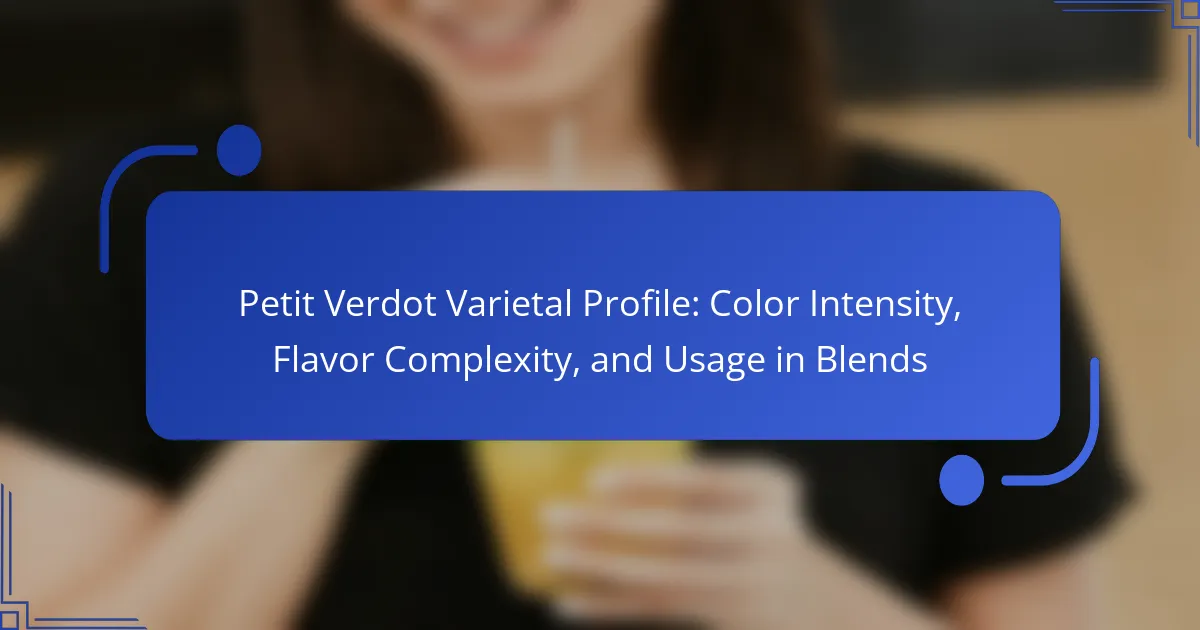
What is the Petit Verdot varietal?
Petit Verdot is a red wine grape varietal known for its deep color and tannic structure. It originates from the Bordeaux region of France. This varietal is often used in blends, particularly in Bordeaux-style wines. Petit Verdot contributes rich flavors of dark fruit, spice, and floral notes. It typically exhibits high acidity and robust tannins. The grape thrives in warm climates, which enhance its flavor profile. Its usage in blends adds complexity and depth to the final wine. Historically, Petit Verdot was used in small quantities due to its late ripening. However, it has gained popularity in recent years for its unique characteristics.
How does Petit Verdot differ from other grape varieties?
Petit Verdot is distinct from other grape varieties primarily due to its high tannin content and deep color. This grape produces wines that are intensely dark, often exhibiting a rich purple hue. The flavor profile of Petit Verdot includes bold notes of dark fruits, such as blackberry and plum, along with floral and herbal nuances.
Additionally, Petit Verdot is known for its late ripening characteristics. This trait makes it less commonly used as a standalone varietal, often serving as a blending component in wines, particularly in Bordeaux blends. Its unique attributes contribute to the structure and complexity of these blends, enhancing their overall profile.
The grape’s ability to impart significant depth and aging potential sets it apart from more commonly utilized varieties, like Merlot or Cabernet Sauvignon. In summary, its high tannins, color intensity, and role in blending define how Petit Verdot differs from other grape varieties.
What are the historical origins of Petit Verdot?
Petit Verdot is a grape variety with origins in the Bordeaux region of France. It has been cultivated since at least the 18th century. Historical records indicate that Petit Verdot was used in Bordeaux blends to enhance color and tannin. The grape thrives in warm climates, which has contributed to its popularity in regions like California and Australia. Its name translates to “little green” in French, referring to its late ripening characteristics. Research shows that Petit Verdot adds depth and complexity to wine blends. Today, it is recognized for its role in both single varietal wines and blends, particularly in red Bordeaux-style wines.
What regions are known for producing Petit Verdot?
Petit Verdot is primarily produced in regions such as Bordeaux, France. Bordeaux is renowned for its red blends, where Petit Verdot is often used in small quantities. Other notable regions include California, particularly in Napa Valley, where it is gaining popularity. Additionally, Australia has emerged as a producer of Petit Verdot, especially in regions like Margaret River. These areas provide the climate and soil conditions conducive to growing this varietal.
What are the key characteristics of Petit Verdot?
Petit Verdot is a red grape variety known for its deep color and bold tannins. It typically exhibits a rich, dark purple hue, contributing to the intensity of blends. The flavor profile includes notes of black fruits, such as blackberry and plum, alongside floral and herbal undertones. Petit Verdot is characterized by high acidity, which adds freshness to wines. It is often used in blends, particularly in Bordeaux-style wines, to enhance complexity and structure. This grape variety thrives in warm climates, allowing for optimal ripening. Historically, Petit Verdot was used sparingly due to its late ripening nature, but it has gained popularity in recent decades.
How does color intensity manifest in Petit Verdot wines?
Color intensity in Petit Verdot wines is notably deep and opaque. This varietal typically exhibits a dark purple to nearly black hue. The high levels of anthocyanins contribute to this intense coloration. Anthocyanins are pigments found in the grape skins. Petit Verdot grapes have thick skins, which enhance color extraction during fermentation. This results in wines that have a vibrant and rich appearance. The color intensity is often a visual indicator of the wine’s potential complexity and aging capability. Studies show that wines with deeper color often correlate with higher tannin levels and flavor concentration.
What flavor profiles are commonly associated with Petit Verdot?
Petit Verdot is commonly associated with rich and bold flavor profiles. It typically exhibits dark fruit flavors such as blackberry and plum. Additionally, it often has floral notes, particularly violet. Spicy elements like black pepper and clove are also prevalent. The wine can present herbal characteristics, including hints of mint or eucalyptus. Oak aging introduces vanilla and chocolate nuances. The tannins are usually firm, contributing to its structure. These flavor profiles make Petit Verdot a popular choice for blending in red wines.
What are the typical aromas found in Petit Verdot?
Petit Verdot typically exhibits aromas of dark fruits, such as blackberry and plum. It also has floral notes, often described as violet or lavender. Spicy characteristics, including black pepper and clove, are commonly present. Additionally, earthy undertones like tobacco and leather can be detected. These aromatic qualities contribute to its complexity in blends. The intensity of these aromas can vary based on the wine’s age and production methods.

How does color intensity impact Petit Verdot wines?
Color intensity significantly impacts Petit Verdot wines by influencing their visual appeal and perceived quality. Deep color often indicates a higher concentration of phenolic compounds. These compounds contribute to the wine’s structure and aging potential. Higher color intensity can enhance the perception of richness and complexity in flavor. It also affects the wine’s mouthfeel, making it feel fuller and more robust. Additionally, color intensity can influence consumer preferences, as darker wines are often associated with boldness. Studies show that wines with greater color intensity tend to receive higher ratings from critics and consumers alike. This correlation suggests that color is an important factor in the overall perception of wine quality.
What factors contribute to the color intensity of Petit Verdot?
The color intensity of Petit Verdot is influenced by several key factors. These factors include the grape’s skin thickness, which is notably high. The anthocyanin content in the skins contributes significantly to color depth. Additionally, the ripeness level at harvest affects the concentration of pigments. Climate and sunlight exposure during the growing season also play critical roles. Warm temperatures enhance color development in the grapes. Finally, winemaking techniques, such as maceration duration, can further intensify the color. These elements collectively define the vibrant hue characteristic of Petit Verdot wines.
How does vineyard management influence color development?
Vineyard management significantly influences color development in grape varieties like Petit Verdot. Factors such as canopy management, irrigation practices, and grape maturity play crucial roles. Proper canopy management allows for optimal sunlight exposure, which enhances anthocyanin production. Anthocyanins are the pigments responsible for red and purple hues in grapes.
Irrigation practices affect vine stress levels, which can also impact color intensity. Controlled water supply during the growing season can lead to better color concentration in the grapes. Additionally, harvesting grapes at the right maturity level ensures maximum color development.
Studies indicate that grapes harvested at peak ripeness show higher anthocyanin levels. For instance, research published in the Journal of Agricultural and Food Chemistry shows a direct correlation between vineyard practices and anthocyanin concentration. This evidence supports the assertion that effective vineyard management is essential for achieving desired color profiles in wines.
What role does climate play in the color intensity of Petit Verdot?
Climate significantly influences the color intensity of Petit Verdot. Warmer climates typically enhance the anthocyanin concentration in the grape skins. Anthocyanins are the pigments responsible for the deep color in red wines. Higher temperatures can lead to increased sugar levels, which also correlates with richer color extraction during fermentation. Conversely, cooler climates may result in lighter color due to lower anthocyanin levels. Studies show that Petit Verdot from regions like Bordeaux exhibits more intense color compared to those from cooler areas. This is attributed to the optimal ripening conditions provided by the warmer climate. Thus, climate plays a crucial role in determining the overall color profile of Petit Verdot wines.
How is color intensity perceived in wine tasting?
Color intensity in wine tasting is perceived through visual assessment of the wine’s hue and depth. The intensity indicates the concentration of pigments, primarily anthocyanins, derived from grape skins. Darker colors often suggest richer flavors and higher tannin levels. For example, Petit Verdot typically exhibits a deep purple to inky black color. This intensity can influence a taster’s expectation of body and complexity. Studies show that color can affect flavor perception, with darker wines often perceived as more robust. Thus, color intensity plays a crucial role in the overall tasting experience.
What visual cues indicate color intensity in Petit Verdot?
The visual cues that indicate color intensity in Petit Verdot include deep, dark hues and opacity. The wine typically presents a rich purple to inky black color. This intensity is a result of high anthocyanin content, which contributes to the pigment. When observing the wine, a thick, viscous appearance can also signify higher color concentration. The presence of staining on the glass indicates a robust color profile. Additionally, Petit Verdot often shows a vibrant rim when swirled, reflecting its depth. These characteristics are consistent with the varietal’s known profile, confirming its reputation for intense coloration.
How does color intensity affect consumer preferences?
Color intensity significantly influences consumer preferences in wine. Higher color intensity often correlates with perceived quality and richness. Consumers tend to associate deep-colored wines with bold flavors and complexity. Research shows that darker wines are frequently chosen over lighter ones in blind tastings. This preference can be attributed to the visual appeal of color, which impacts initial judgments. Studies indicate that color can evoke emotional responses, affecting overall enjoyment. Consequently, winemakers often aim for optimal color intensity to enhance market appeal. The relationship between color intensity and consumer preference is well-documented in wine marketing literature.

What is the flavor complexity of Petit Verdot?
Petit Verdot exhibits a rich flavor complexity characterized by dark fruit notes. Common flavors include blackberry, plum, and cherry. It often has herbal undertones, such as violet and mint. The wine can also present spice notes, including black pepper and clove. Tannins in Petit Verdot are typically firm, contributing to its structure. The acidity is moderate, enhancing its ability to age well. This varietal is often used in blends to add depth and complexity. Its flavor profile can vary significantly based on the region and winemaking techniques used.
What are the primary flavors found in Petit Verdot wines?
Petit Verdot wines primarily exhibit flavors of dark fruits, such as blackberry and plum. These wines often have floral notes, including violet and lavender. Additionally, Petit Verdot can present spicy characteristics, like black pepper and clove. Earthy undertones, such as tobacco and leather, are also common. The wine’s tannins contribute to a structured mouthfeel, enhancing its flavor complexity. These attributes make Petit Verdot a popular choice for blending in red wine production. The grape’s intense flavor profile often complements other varietals, adding depth to wine blends.
How do tannins contribute to the flavor complexity of Petit Verdot?
Tannins significantly enhance the flavor complexity of Petit Verdot. They provide structure and astringency, which balance the wine’s fruitiness. This balance allows for a richer mouthfeel and deeper flavor profile. Tannins also interact with other compounds, contributing to the wine’s aging potential. Over time, they soften, revealing more nuanced flavors. Research indicates that Petit Verdot typically has higher tannin levels compared to other varietals. This characteristic is crucial in blending, as it adds depth and complexity to the final wine.
What role does aging play in developing flavor complexity?
Aging significantly enhances flavor complexity in Petit Verdot wines. The process allows chemical reactions to occur, which develop deeper and more nuanced flavors. During aging, compounds like tannins and acids evolve, softening the wine’s structure. This evolution leads to the integration of various flavor notes, such as fruit, spice, and earthiness. Studies show that aged wines often exhibit more harmonious profiles compared to their younger counterparts. Additionally, exposure to oxygen during aging can promote the formation of complex aromatic compounds. This results in a richer, more layered flavor experience. Overall, aging is crucial for achieving the desired flavor complexity in Petit Verdot wines.
How does flavor complexity affect food pairings?
Flavor complexity significantly influences food pairings by enhancing the overall dining experience. Complex flavors in food can complement or contrast with the flavors in wine, creating a harmonious balance. For instance, a wine with high flavor complexity, such as Petit Verdot, pairs well with rich, savory dishes. This is because the wine’s intricate notes can mirror or elevate the flavors of the food. Additionally, dishes with layered flavors can match the depth found in complex wines. Research indicates that successful pairings often involve matching the intensity and complexity of both food and wine. Therefore, understanding flavor complexity is essential for creating effective food and wine pairings.
What types of cuisine complement Petit Verdot’s flavor profile?
Rich, bold cuisines complement Petit Verdot’s flavor profile. Dishes featuring grilled meats enhance its robust tannins. Barbecue and smoked meats pair well with its dark fruit notes. Hearty stews and game meats also match its complexity. Additionally, rich sauces like red wine reductions elevate the wine’s character. Spicy cuisines, such as Indian or Mexican, can contrast nicely with its depth. Lastly, aged cheeses provide a savory balance to Petit Verdot’s intensity.
How can flavor complexity enhance the dining experience?
Flavor complexity enhances the dining experience by providing a multi-dimensional taste profile. This complexity engages the palate, making each bite or sip more interesting. It allows for a greater range of flavors to be perceived simultaneously. Dishes with layered flavors can evoke emotional responses and memories. Research shows that complex flavors can stimulate appetite and increase enjoyment. For example, wines like Petit Verdot exhibit rich flavor complexity, enhancing food pairings. This results in a more satisfying and memorable meal. Ultimately, flavor complexity transforms dining into an exploration of taste.

What is the usage of Petit Verdot in blends?
Petit Verdot is primarily used in blends to enhance color, structure, and complexity. It contributes deep color intensity to red wine blends. The grape also adds tannins, which help in aging potential. Its flavor profile includes dark fruit notes, spice, and floral characteristics. These attributes complement other varietals like Cabernet Sauvignon and Merlot. In Bordeaux blends, Petit Verdot is often used in small percentages. It typically comprises 2% to 10% of the blend. This usage balances the overall flavor and texture of the wine.
Why is Petit Verdot used in wine blends?
Petit Verdot is used in wine blends primarily for its color intensity and flavor complexity. This varietal contributes deep, rich hues to the blend. It adds bold flavors, including dark fruit and floral notes. Petit Verdot also enhances the overall structure and tannin profile of the wine. Its high acidity provides balance in blends, making them more vibrant. Historically, it has been valued in Bordeaux blends for these qualities. The grape’s ability to ripen late adds unique characteristics that complement other varietals. Overall, Petit Verdot enriches blends, improving both taste and appearance.
What benefits does Petit Verdot bring to blended wines?
Petit Verdot enhances blended wines by adding color intensity, flavor complexity, and structure. Its deep, dark color contributes to the visual appeal of the blend. The varietal offers rich flavors, including blackberry, plum, and floral notes, which elevate the overall taste profile. Petit Verdot also provides tannin structure, enhancing the wine’s mouthfeel and aging potential. Its high acidity helps balance the sweetness in other varietals, promoting harmony in the blend. Additionally, Petit Verdot’s unique characteristics can add complexity, making the final wine more intriguing. These attributes have made it a valued choice in renowned blends, particularly in Bordeaux wines.
What are some notable blends that include Petit Verdot?
Notable blends that include Petit Verdot are often found in Bordeaux-style wines. These blends typically combine Petit Verdot with Cabernet Sauvignon and Merlot. One prominent example is the Château Margaux, which features this varietal for added structure and depth. Another notable blend is the Opus One, known for its rich complexity. Additionally, the Dominus Estate incorporates Petit Verdot, enhancing its flavor profile. These wines showcase how Petit Verdot contributes to tannin structure and color intensity.
How does blending with Petit Verdot influence wine characteristics?
Blending with Petit Verdot enhances wine characteristics by adding depth and complexity. It contributes to color intensity, often resulting in a darker wine. Petit Verdot’s tannins provide structure and ageability. It introduces floral and herbal notes, enriching the aromatic profile. Additionally, the varietal’s acidity can balance sweeter wines. The integration of Petit Verdot can improve overall mouthfeel, making wines feel fuller. In Bordeaux blends, it typically comprises a small percentage, yet its impact is significant. Studies show that wines with Petit Verdot exhibit improved longevity and complexity, making them more desirable.
What are the effects of blending on tannin structure and mouthfeel?
Blending affects tannin structure by integrating tannins from different grape varieties. This integration can create a more balanced tannin profile. The resulting mouthfeel may become smoother and more complex. For example, Petit Verdot’s robust tannins can soften when blended with softer varieties like Merlot. This blending process can enhance the overall texture and mouthfeel of the wine. Research indicates that the interaction of tannins during blending can lead to a more harmonious taste experience. Blending also allows winemakers to adjust the astringency and bitterness levels in the final product. Thus, blending is a crucial technique for optimizing tannin structure and mouthfeel in wines.
How does Petit Verdot enhance the aroma profile of blends?
Petit Verdot enhances the aroma profile of blends by contributing rich, dark fruit notes. These notes include blackberry, plum, and black cherry, which add depth to the overall aroma. Additionally, Petit Verdot introduces floral characteristics, such as violet and lavender. The variety also delivers herbal nuances, including hints of mint or eucalyptus. Its tannic structure supports the integration of these aromatic components, creating a balanced profile. Research indicates that blends with Petit Verdot often exhibit increased complexity and intensity. This complexity makes it a valuable component in many red wine blends, particularly with Cabernet Sauvignon and Merlot.
What tips can enhance your appreciation of Petit Verdot wines?
To enhance your appreciation of Petit Verdot wines, focus on tasting them at the right temperature. Serving Petit Verdot slightly cooler, around 60-65°F, highlights its complex flavors. Pay attention to the wine’s color intensity; deep purple hues indicate rich flavor profiles. Take note of the aromatic complexity; scents of dark fruits, spice, and floral notes are common. Pair Petit Verdot with hearty dishes like grilled meats or rich stews to complement its bold character. Consider exploring different vintages to understand its aging potential and how flavors evolve over time. Lastly, engage in discussions with knowledgeable sommeliers or attend tastings to deepen your understanding of its unique attributes.
Petit Verdot is a red wine grape varietal originating from Bordeaux, France, known for its deep color, high tannin content, and complex flavor profile. This article explores the varietal’s key characteristics, including its intense color, rich flavors of dark fruits and spices, and its role in enhancing the complexity of wine blends, particularly in Bordeaux-style wines. Additionally, it examines the historical origins of Petit Verdot, the regions where it is produced, and the factors influencing its color intensity and flavor complexity. The article also discusses the impact of blending Petit Verdot with other varietals, highlighting its contributions to aroma, structure, and mouthfeel in wine.
